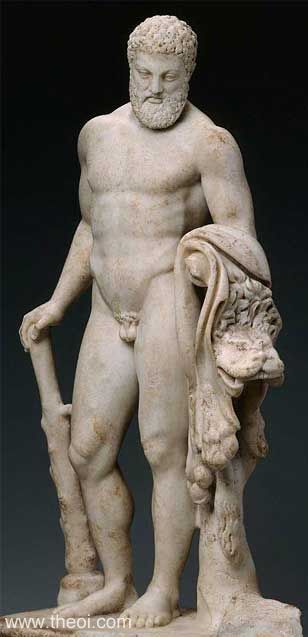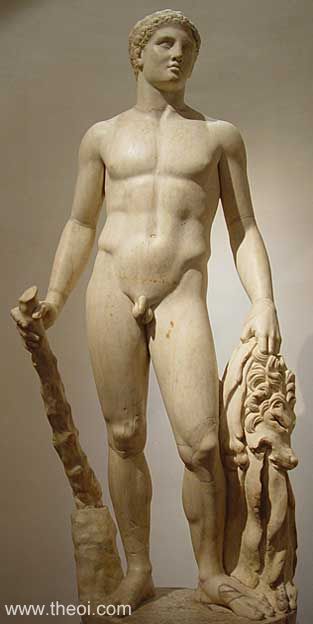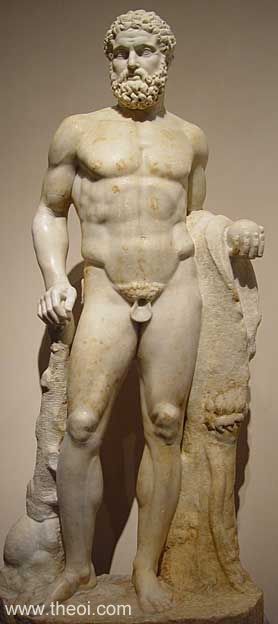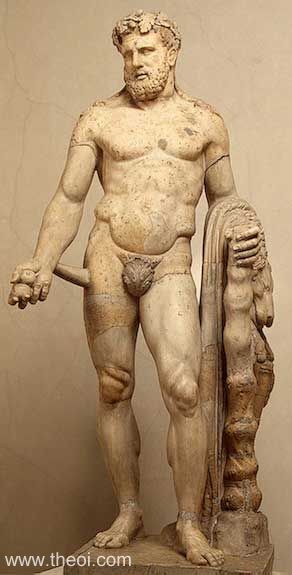HERAKLES CULT 2
Greek Name
Ἑρακλης
Transliteration
Heraklês
Latin Spelling
Heracles
Roman Name
Hercules

HERAKLES was an Olympian demigod worshipped as the divine protector of mankind.
This page describes his cult in Akhaia, Arkadia, central and northern Greece, and the Aegean. His main shrine in the region was located in the town of Thebes.
CLASSICAL LITERATURE QUOTES
CULT IN ACHAEA (SOUTHERN GREECE)
I. AEGIUM (AIGION) Town in Achaea (Akhaia)
Pausanias, Description of Greece 7. 23. 10 (trans. Jones) (Greek travelogue C2nd
A.D.) :
"In a building right in front of the entrance [of the temple of Zeus Soter in Aigion] are images, of bronze
like the others, representing Poseidon, Herakles, Zeus and Athena. They are called gods from Argos. The Argives
say it is because they were made in Argos; the people of Aegion themselves say that the images were deposited by
the Argives with them on trust."
Pausanias, Description of Greece 7. 24. 1 :
"The beach, on which the people of Aegion have the sanctuaries I have mentioned [i.e. of Zeus the Assember
and others], affords a plentiful supply of water from a spring; it is pleasing both to the eye and to the taste
. . . here are at Aegion other images made of bronze, Zeus as a boy and Herakles as a beardless youth, the work
of Ageladas of Argos. Priests are elected for them every year, and each of the two images remains at the house
of the priest. In a more remote age there was chosen to be priest for Zeus from the boys he who won the prize
for beauty. When his beard began to grow the honor for beauty passed to another boy. Such were the
customs."
II. Near BURA (BOURA) Village in Achaea
Pausanias, Description of Greece 7. 25. 10 :
"On descending from Boura towards the sea you come to a river called Bouraikos, and to a small Herakles in
a cave. He too is surnamed Bouraikos, and here one can divine by means of a tablet and dice. He who inquires of
the god offers up a prayer in front of the image, and after the prayer he takes four dice, a plentiful supply of
which are placed by Herakles, and throws them upon the table. For every figure made by the dice there is an
explanation expressly written on the tablet."
CULT IN ARCADIA (SOUTHERN GREECE)
I. MEGALOPOLIS Main City of Arcadia (Arkadia)
Pausanias, Description of Greece 8. 31. 7 :
"Within the enclosure of the goddesses [Demeter and Kore at Megalopolis] are the following images, which
all have a square shape: Hermes, surnamed Agetor, Apollon, Athena, Poseidon, Helios (the Sun) too, surnamed
Soter (Saviour), and Herakles."
Pausanias, Description of Greece 8. 32. 3 :
"The temple near the race-course [of Megalopollis] shared by Herakles and Hermes was no longer there, only
their altar was left."
II. Near PHAEDRIES (PHAIDRIES) Village in Arcadia
Pausanias, Description of Greece 8. 35. 2 :
"About fifteen stades distant from Phaidries is an Hermaion (Temple of Hermes) called 'by the Mistress'; it
too forms a boundary between Messenia and Megalopolis [in Arkadia]. There are small images of Despoine (the
Mistress) and Demeter; likewise of Hermes and Herakles. I am of opinion that the wooden image also, made for
Herakles by Daidalos [mythical artisan], stood here on the borders of Messenia and Arkadia."
III. TEGEA Town in Arcadia
Pausanias, Description of Greece 8. 53. 9 :
"The Tegeans also have what they call a Common Hearth of the Arkadians. Here there is an image of Herakles,
and on his thigh is represented a wound received in the first fight with the sons of Hippokoon."
CULT IN BOEOTIA (CENTRAL GREECE)

I. THEBES Main City of Boeotia (Boiotia)
Pausanias, Description of Greece 9. 11. 1 :
"On the left of the gate named Elektran [at Thebes] are the ruins of a house where they say Amphitryon came
to live when exiled from Tiryns because of the death of Elektryon; and the chamber of Alkmena is still plainly
to be seen among the ruins. They say that it was built for Amphitryon by Trophonios and Agamedes, and that on it
was written the following inscription:--‘When Amphitryon was about to bring hither his bride Alkmena, he
chose this as a chamber for himself. Ankhasian Trophonios and Agamedes made it.’
Such was the inscription that the Thebans say was written here. They show also the tomb of the children of
Herakles by Megara. Their account of the death of these is in no way different from that in the poems of
Panyassis and of Stesikhoros of Himera. But the Thebans add that Herakles in his madness was about to kill
Amphitryon as well, but before he could do so he was rendered unconscious by the blow of the stone. Athena, they
say, threw at him this stone, which they name Chastiser.
Here are portraits of women in relief, but the figures are by this time rather indistinct. The Thebans call them
Witches (Pharmakides), adding that they were sent by Hera to hinder the birth-pangs of Alkmena. So these kept
Alkmena from bringing forth her child. But Historis, the daughter of Teiresias, thought of a trick to deceive
the Witches, and she uttered a loud cry of joy in their hearing, that Alkmena had been delivered. So the story
goes that the Witches were deceived and went away, and Alkmena brought forth her child.
Here is a sanctuary of Herakles. The image, of white marble, is called Promakhos (Champion), and the Thebans
Xenokritos and Eubios were the artists. But the ancient wooden image is thought by the Thebans to be by
Daidalos, and the same opinion occurred to me. It was dedicated, they say, by Daidalos himself, as a
thank-offering for a benefit. For when he was fleeing from Krete in small vessels which he had made for himself
and his son Ikaros, he devised for the ships sails, an invention as yet unknown to the men of those times, so as
to take advantage of a favorable wind and outsail the oared fleet of Minos. Daidalos himself was saved, but the
ship of Ikaros is said to have overturned, as he was a clumsy helmsman. The drowned man was carried ashore by
the current to the island, then without a name, that lies off Samos. Herakles came across the body and
recognized it, giving it burial where even to-day a small mound still stands to Ikaros on a promontory jutting
out into the Aegean. After this Ikaros are named both the island and the sea around it.
The carvings on the gables at Thebes are by Praxiteles, and include most of what are called the twelve labours.
The slaughter of the Stymphalian birds and the cleansing of the land of Elis by Herakles are omitted; in their
place is represented the wrestling with Antaios. Thrasyboulos, son of Lykos, and the Athenians who with him put
down the tyranny of the Thirty [403 B.C.], set out from Thebes when they returned to Athens, and therefore they
dedicated in the sanctuary of Herakles colossal figures of Athena and Herakles, carved by Alkamenes in relief
out of Pentelic marble.
Adjoining the sanctuary of Herakles are a gymnasium and a race-course, both being named after the god. Beyond
the Chastiser stone is an altar of Apollon surnamed God of Ashes; it is made out of the ashes of the
victims."
Pausanias, Description of Greece 9. 39. 3 :
“Of all the works of [the mythical craftsman Daidalos] Daidalos there are these two in Boiotia, a Herakles
in Thebes and the Trophonios at Lebadeia . . . I know of no other works of Daedalus still in existence."
Pausanias, Description of Greece 9. 25. 4 :
"Along the road from the Neistan gate [of Thebes] are three sanctuaries. There is a sanctuary of Themis . .
. of the Moirai (Fates), while the third is of Zeus . . . A little farther off in the open stands Herakles,
surnamed Rhinokoloustes (Nose-docker); the reason for the name is, as the Thebans say, that Herakles cut off the
noses, as an insult, of the heralds who came from Orkhomenos to demand the tribute."
Antoninus Liberalis, Metamorphoses 20 (trans. Celoria) (Greek mythographer C2nd A.D.)
:
"Herakles, when he grew up, remembered the favour she [Galanthias who had tricked Eileithyia into allowing
the birth of Herakles and was transformed by a goddess into a weasel] had done for him and made an image of her
to set by his house and offered her sacrifices. The Thebans even now maintain these rites and, before the
festival of Herakles, sacrifice to Galinthias first."
Ptolemy Hephaestion, New History Book 3 (summary from Photius, Myriobiblon 190)
(trans. Pearse) (Greek mythographer C1st to C2nd A.D.) :
"Who wrote the hymn which is chanted at Thebes in honour of Herakles and where he is called son of Zeus and
Hera?"
II. TENERUS PLAIN (TENEROS) Plain near Thebes in Boeotia
Pausanias, Description of Greece 9. 26. 1 (trans. Jones) (Greek travelogue C2nd A.D.)
:
"[There] is a plain named after Teneros the seer, whom they hold to be a son of Apollon by Melia; there is
also a large sanctuary of Herakles surnamed Hippodetos (Binder of Horses). For they say that the Orkhomenians
came to this place with an army [to attack Thebes], and that Herakles by night took their chariot-horses and
bound them tight."
III. Near MYCALESSUS (MYKALESSSOS) Village in Boeotia
Pausanias, Description of Greece 9. 19. 5 :
"On the way to the coast of Mykalessos is a sanctuary of Demeter Mykalessia. They say that each night it is
shut up and opened again by Herakles, and that Herakles is one of what are called the Daktyloi Idaioi [or
perhaps originally the hero]. Here is shown the following marvel. Before the feet of the image they place all
the fruits of autumn, and these remain fresh throughout all the year."
Pausanias, Description of Greece 9. 27. 8 :
"The Boiotians were not unacquainted with this name [Idaios] of Herakles, seeing that they themselves say
that the sanctuary of Demeter of Mykalessos has been entrusted to Herakles Idaios."
IV. HYTETTUS (HYTETTOS) Village in Boeotia
Pausanias, Description of Greece 9. 24. 3 :
"In Hytettos [near Orkhomenos in Boiotia] is a temple of Herakles from whom the sick may get cures. There
is an image not carefully carved, but of unwrought stone after the ancient fashion."
V. THESPIAE (THESPIAI) Town in Boeotia
Pausanias, Description of Greece 9. 27. 6 :
"At Thespiai is also a sanctuary of Herakles. The priestess there is a virgin, who acts as such until she
dies. The reason of this is said to be as follows. Herakles, they say, had intercourse with the fifty daughters
of Thestios, except one, in a single night. She was the only one who refused to have connection with him.
Herakles,thinking that he had been insulted, condemned her to remain a virgin all her life, serving him as his
priest.
I have heard another story, how Herakles had connection with all the virgin daughters of Thestios in one and the
same night, and how they all bore him sons, the youngest and the eldest bearing twins. But I cannot think it
credible that Herakles would rise to such a pitch of wrath against a daughter of a friend. Moreover, while he
was still among men, punishing them for insolence, and especially such as were impious towards the gods, he
would not himself have set up a temple and appointed a priestess to himself, just as though he were a god.
As a matter of fact this sanctuary seemed to me too old to be of the time of Herakles the son of Amphitryon
[this is purely an opinion of Pausanias], and to belong to Herakles called one of the Daktyloi Idaioi, to whom I
found the people of Erythrai in Ionia and of Tyre possessed sanctuaries. Nevertheless, the Boiotians were not
unacquainted with this name of Herakles, seeing that they themselves say that the sanctuary of Demeter of
Mykalessos has been entrusted to Herakles Idaios."
VI. THISBE Village in Boeotia
Pausanias, Description of Greece 9. 31. 2 :
"There is a town called Thisbe. First there is a mountain by the sea; on crossing it you will come to a
plain, and after that to another mountain, at the foot of which is the city. there is a sanctuary of Herakles
with a standing image of stone, and they hold a festival called the Herakleia."
VII. TIPHA Village in Boeotia
Pausanias, Description of Greece 9. 31. 4 :
"Tipha [in Boiotia], a small town by the sea. The townsfolk have a sanctuary of Herakles and hold an annual
festival."
VIII. MT. LAPHYSTIUS (LAPHYSTIOS) Mountain in Boeotia
Pausanias, Description of Greece 9. 34. 5 :
"The distance from Coroneia to Mount Laphystius and the precinct of Zeus Laphysios is about twenty stades .
. . Higher up is a Herakles surnamed Kharops (With bright eyes). Here, say the Boiotians, Heracles ascended with
the hound of Haides."
IX. Near ORCHOMENUS (ORKHOMENOS) Town in Boeotia
Pausanias, Description of Greece 9. 38. 6 :
"Seven stades from Orkhomenos [in Boiotia] is a temple of Herakles with a small image. Here is the source
of the river Melas (black), one of the streams running into the Kephisian Lake. The lake at all times covers the
greater part of the Orkhomenian territory, but in the winter season, after the south-west wind has generally
prevailed, the water spreads over a yet greater extent of the territory.
The Thebans declare that the river Kephisos was diverted into the Orkhomenian plain by Herakles, and that for a
time it passed under the mountain and entered the sea, until Herakles blocked up the chasm through the
mountain."
CULT IN PHOCIS (CENTRAL GREECE)

I. DELPHI (DELPHOI) Town & Sanctuary in Phocis (Phokis)
Pausanias, Description of Greece 10. 13. 6 :
"The image of Herakles [amongst the dedications at Delphoi] is a votive offering of the Thebans, sent when
they had fought what is called the Sacred War against the Phokians . . .
[In another sculpture group :] Herakles and Apollon are holding on to the tripod, and are preparing to fight
about it. Leto and Artemis are calming Apollon, and Athena is calming Herakles. This too is an offering of the
Phokians, dedicated when Tellias of Elis led them against the Thessalians. Athena and Artemis were made by
Khionis, the other images are works shared by Diyllos and Amyklaios. They are said to be Korinthians."
Pausanias, Description of Greece 10. 18. 6 :
"There is here one [dedicated statue at Delphoi] of the labours of Herakles, namely, his fight with the
Hydra. Tisagoras not only dedicated the offering, but also made it. Both the Hydra and Herakles are of iron. To
make images of iron is a very difficult task, involving great labour. So the work of Tisagoras, whoever he was,
is marvellous."
CULT IN OZOLIAN LOCRIS (CENTRAL GREECE)
I. BATHS OF HERACLES Hot-Water Springs in Lokris
Antoninus Liberalis, Metamorphoses 4 (trans. Celoria) (Greek mythographer C2nd A.D.)
:
"Krageleus, son of Dryops, lived in the land of Dryopis near the Baths of Herakles which, tellers of myths
say, Herakles caused to well up when he struck the mountain's table-top with his club."
CULT IN ACARNANIA (CENTRAL GREECE)
I. ALYZIA Town in Acarnania (Akarnania)
Strabo, Geography 10. 2. 21 (trans. Jones) (Greek geographer C1st B.C. to C1st A.D.)
:
"Palairos and Alyzia, cities of Akarnania [in Aitolia]; of these, Alyzia is fifteen stadia distant from the
sea, where is a harbor sacred to Herakles and a sacred precinct. It is from this precinct that one of the
commanders carried to Rome the ‘Labours of Herakles,’ works of Lysippos, which were lying out of
place where they were, because it was a deserted region."
CULT IN OPUNTIAN LOCRIS (CENTRAL GREECE)
I. THERMOPYLAE (THERMOPYLAI) & MT. OETA (OITA) Town & Mountain in Locris (Lokris)
Strabo, Geography 9. 4. 13 :
"The pass [of Mount Oita by Opuntian Lokris] is called not only Pylai . . . but also Thermopylai, for there
are hot waters near it that are held in honor as sacred to Herakles."
Herodotus, Histories 7. 176. 3 (trans. Godley) (Greek historian C5th B.C.)
:
"The pass through Trakhis into Hellas is fifty feet wide at its narrowest point. It is not here, however,
but elsewhere that the way is narrowest, namely, in front of Thermopylai and behind it; at Alpeni, which lies
behind, it is only the breadth of a cart-way, and it is the same at the Phoinix stream, near the town of
Anthele. To the west of Thermopylai rises a high mountain, inaccessible and precipitous, a spur of Oeta; to the
east of the road there is nothing but marshes and sea. In this pass are warm springs for bathing, called the
Basins by the people of the country, and an altar of Herakles stands nearby. Across this entry a wall had been
built, and formerly there was a gate in it."
N.B. The name Thermopylai means "thermal springs of the gates"--the gates being the coastal mountain pass.
CULT IN MALIS (NORTHERN GREECE)
I. MT. OETA (OITA) Mountain in Malis
Strabo, Geography 13. 1. 64 (trans. Jones) (Greek geographer C1st B.C. to C1st A.D.)
:
"It is from locusts (parnopes), they say, which the Oitaians call kornopes, that Herakles
is worshipped among the Oitaians as Kornopion (of the Locusts), for ridding them of locusts."
Herodotus, Histories 7. 198. 1 (trans. Godley) (Greek historian C5th B.C.)
:
"About twenty furlongs from that river [Sperkheios in Malis] is another [river] named Dyras, which is said
to have risen from the ground to aid Herakles against the fire that consumed him [at his death]."
Ptolemy Hephaestion, New History Book 2 (summary from Photius, Myriobiblon 190)
(trans. Pearse) (Greek mythographer C1st to C2nd A.D.) :
"From the pyre of Herakles a swarm of locusts flew out which ravaged the countryside like a plague before
they were destroyed."
CULT IN EPIRUS (NORTHERN GREECE)

I. AMBRACIA (AMBRAKIA) Main City of Epirus (Epeiros)
Antoninus Liberalis, Metamorphoses 4 (trans. Celoria) (Greek mythographer C2nd A.D.)
:
“Krageleus [king of Dryopis, aka Ozolian Lokris] was at this time already and old man and was considered
by his countrymen to be just and wise. While he was pasturing his cattle, Apollon, Artemis and Herakles
introduced themselves to him since they wanted a decision about Ambrakia in Epeiros.
Apollon said that the city belonged to him . . . [He gives his reasons.]
Artemis on her part was for keeping her dispute with Apollon within bounds, but claimed that she had acquired
Ambrakia with his consent . . . [She makes her claims.]
Herakles in his turn put forward the argument that Ambrakia and the whole of Epeiros belonged to him. All the
peoples that had made war with him [when he was mortal], Keltoi, Khaonians, Thesprotians, and all the Epirotes,
ahd been defeated by him after they had formed an alliance to steal the cattle of Geryon. Some time after, a
settlement of colonists from Korinthos had expelled the original settlement of colonists and founded Ambrakia.
All the Korinthians are descended from Herakles.
Kragaleus heard these arguments through to the end and recognised that the city belonged to Herakles. Apollon
became enraged, touched Kragaleos with his hand and turned him into a stone where he stood. The Ambrakiotes
sacrifice to Apollon as the Saviour, but they have acknowledged that the city was that of Herakles and his sons.
To this day they make sacrifice to Kragaleus after the feast of Herakles."
CULT IN SAMOS (GREEK AEGEAN)
I. SAMOS Main Town of Samos
Strabo, Geography 14. 1. 14 (trans. Jones) (Greek geographer C1st B.C. to C1st A.D.)
:
"The temple [of Hera on the Greek Island of Samos], which is open to the sky, is likewise full of most
excellent statues. Of these, three of colossal size, the work of Myron, stood upon one base; Antony took these
statues away, but Augustus Caesar restored two of them, those of Athena and Herakles, to the same base."
CULT IN THASOS (GREEK AEGEAN)
I. THASOS Main Town of Thasos
Pausanias, Description of Greece 5. 25. 12 (trans. Jones) (Greek travelogue C2nd
A.D.) :
"The Thasians, who are Phoenicians by descent, and sailed from Tyre, and from Phoenicia generally, together
with Thasos, the son of Agenor, in search of Europa, dedicated at Olympia a Herakles, the pedestal as well as
the image being of bronze. The height of the image is ten cubits, and he holds a club in his right hand and a
bow in his left. They told me in Thasos that they used to worship the same Heracles as the Tyrians [N.B.
Herakles was identified with the Phoenician god Tammuz], but that afterwards, when they were included among the
Greeks, they adopted the worship of Heracles the son of Amphitryon."
Pausanias, Description of Greece 6. 11. 2 :
"Not far from the kings mentioned [amongst the dedications at Olympia] stands a [statue of a] Thasian,
Theagenes the son of Timosthenes [a famous victor in the wrestling and boxing events of the Olympics]. The
Thasians say that Timosthenes was not the father of Theagenes, but rather a priest of Herakles Thasios (of
Thasos), a phantom of whom in the likeness of Timosthenes had intercourse with the mother of Theagenes."
SOURCES
GREEK
- Herodotus, Histories - Greek History C5th B.C.
- Strabo, Geography - Greek Geography C1st B.C. - C1st A.D.
- Pausanias, Description of Greece - Greek Travelogue C2nd A.D.
- Antoninus Liberalis, Metamorphoses - Greek Mythography C2nd A.D.
- Ptolemy Hephaestion, New History - Greek Mythography C1st - 2nd A.D.
BYZANTINE
- Photius, Myriobiblon - Byzantine Greek Scholar C9th A.D.
BIBLIOGRAPHY
A complete bibliography of the translations quoted on this page.